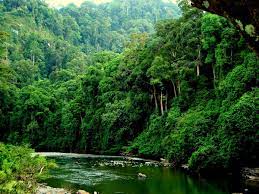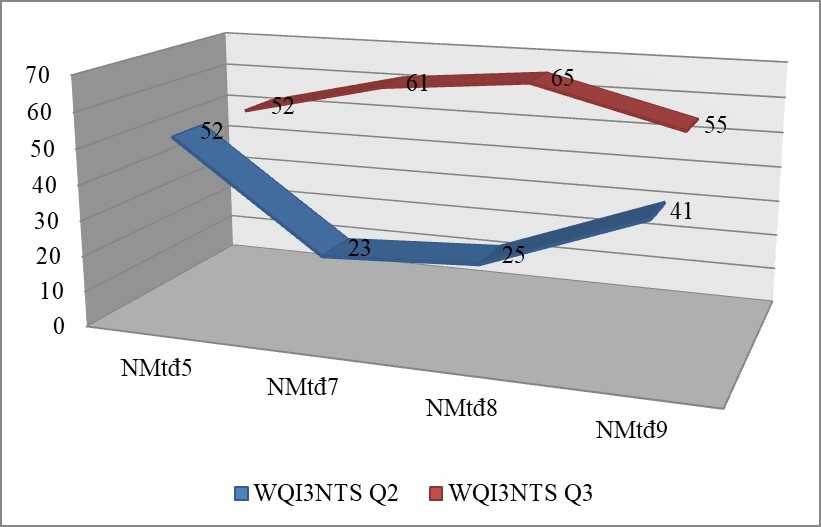05. TỔNG QUAN CÁC NHÂN TỐ ẢNH HƯỞNG ĐẾN TÁI SINH TỰ NHIÊN CỦA RỪNG NHIỆT ĐỚI
Giới thiệu
Tái sinh tự nhiên là một thành phần rất quan trọng của động thái rừng và sự phát triển bền vững của hệ sinh thái rừng nhiệt đới. Do đó, hiểu được các nhân tố ảnh hưởng đến tái sinh rừng là rất quan trọng quyết định đến sự thành công hay thất bại của công tác phục hồi rừng. Mục tiêu chính của bài báo này là đánh giá tổng quan từ các tài liệu nghiên cứu trên thế giới về các nhân tố ảnh hưởng đến tái sinh tự nhiên trong rừng nhiệt đới. Kết quả cho thấy rằng, các nhân tố ảnh hưởng đến tái sinh tự nhiên của các loài cây rừng nhiệt đới có thể bao gồm sự cạnh tranh từ thảm thực vật không mong muốn, động vật ăn hạt và ăn cây con, thiếu nguồn hạt giống do khả năng phát tán hạt giống bị hạn chế, tỷ lệ nảy mầm của hạt giống là thấp,... Thông tin trong bài báo có thể cung cấp cho các nhà quản lý, các nhà khoa học, nhà lâm nghiệp một bức tranh toàn diện về các nhân tố ảnh hưởng đến tái sinh rừng, làm cơ sở xây dựng các biện pháp kỹ thuật lâm sinh nhằm xúc tiến quá trình phục hồi của hệ sinh thái rừng.
Toàn văn bài báo
Trích dẫn
[2]. Aide, T. M., Zimmerman, J. K., Herrera, L., Rosario, M. & Serrano, M. (1995). Forest recovery in abandoned tropical pastures in Puerto Rico. Forest Ecology and Management, 77, 77 - 86.
[3]. Ashton, P., Gamage, S., Gunatilleke, I. & Gunatilleke, C. (1997). Restoration of a Sri Lankan rainforest: Using Caribbean pine Pinus caribaea as a nurse for establishing late-successional tree species. Journal of Applied Ecology, 34, 915 - 925.
[4]. Beguin, J., Pothier, D., Prévost, M. (2009). Can the impact of deer browsing on tree regeneration be mitigated by shelterwood cutting and strip clearcutting? Forest Ecology and Management, 257, 38 - 45.
[5]. Bendell, J. F. (1974). Effects of fire on birds and mammals. Fire and Ecosystems, 73 - 138.
[6]. Barrere, J., Petersson, L. K., Boulanger, V., Collet, C., Felton, A. M., Löf, M., & Saïd, S. (2021). Canopy openness and exclusion of wild ungulates act synergistically to improve oak natural regeneration. Forest Ecology and Management, 487, 118976.
[7]. de Oliveira, C. D. C., Durigan, G., & Putz, F. E. (2021). Thinning temporarily stimulates tree regeneration in a restored tropical forest. Ecological Engineering, 171, 106390.
[8]. Corlett, R. T. (1998). Frugivory and seed dispersal by vertebrates in the Oriental (Indomalayan) Region. Biological Reviews, 73, 413 - 448.
[9]. Corlett, R. T. (2017). Frugivory and seed dispersal by vertebrates in tropical and subtropical Asia: An update. Global Ecology Conservation, 11, 1 - 22.
[10]. Cramer, J. M., Mesquita, R. C. & Williamson, G. B. (2007). Forest fragmentation differentially affects seed dispersal of large and small-seeded tropical trees. Biological Conservation, 137, 415 - 423.
[11]. Duncan, R. S. & Chapman, C. A. (2002). 29 limitations of animal seed dispersal for enhancing forest succession on degraded lands. In Levey D. J., Silva W. R. & Galetti M. (eds.) Seed Dispersal and Frugivory: Ecology, Evolution and Conservation. New York: CABI Publishing, p. 437.
[12]. Duncan, R. S. & Chapman, C. A. (2003). Consequences of plantation harvest during tropical forest restoration in Uganda. Forest Ecology and Management, 173, 235 - 250.
[13]. Ewel, J., Berish, C., Brown, B., Price, N. & Raich, J. (1981). Slash and burn impacts on a Costa Rican wet forest site. Ecology, 62, 816 - 829.
[14]. Gill, R. & Morgan, G. (2010). The effects of varying deer density on natural regeneration in woodlands in lowland Britain. Forestry, 83, 53 - 63.
[15]. Graham, L. L., Giesen, W. & Page, S. E. (2017). A common‐sense approach to tropical peat swamp forest restoration in Southeast Asia. Restoration Ecology, 25, 312 - 321.
[16]. Guevara, S. & Laborde, J. (1993). Monitoring seed dispersal at isolated standing trees in tropical pastures: consequences for local species availability. In Fleming T.H., Estrada A. (eds) Frugivory and seed dispersal: Ecological and evolutionary aspects. Advances in vegetation science, vol 15. Dordrecht: Springer.
[17]. Guevara, S., Purata, S. E., & Van der Maarel, E. (1986). The role of remnant forest trees in tropical secondary succession. Vegetatio, 66, 77 - 84.
[18]. Hardwick, K., Healey, J., Elliott, S., Garwood, N. & Anusarnsunthorn, V. (1997). Understanding and assisting natural regeneration processes in degraded seasonal evergreen forests in northern Thailand. Forest Ecology and Management, 99, 203 - 214.
[19]. Hau, C. H. (1997). Tree seed predation on degraded hillsides in Hong Kong. Forest Ecology and Management, 99, 215 - 221.
[20]. Holl, K. D. & Lulow, M. E. (1997). Effects of species, habitat and distance from edge on post‐dispersal seed predation in a tropical rainforest. Biotropica, 29, 459 - 468.
[21]. Holl, K. D. (1998). Do bird perching structures elevate seed rain and seedling establishment in abandoned tropical pasture? Restoration Ecology, 6, 253 - 261.
[22]. Holl, K. D. (1999). Factors limiting tropical rain forest regeneration in abandoned pasture: Seed rain, seed germination, microclimate and soil. Biotropica, 31, 229 - 242.
[23]. Holl, K. D., Loik, M. E., Lin, E. H. & Samuels, I. A. (2000). Tropical montane forest restoration in Costa Rica: Overcoming barriers to dispersal and establishment. Restoration Ecology, 8, 339 - 349.
[24]. Hooper, E., Legendre, P. & Condit, R. (2005). Barriers to forest regeneration of deforested and abandoned land in Panama. Journal of Applied Ecology, 42, 1165 - 1174.
[25]. Howe, H. F. & Smallwood, J. (1982). Ecology of seed dispersal. Annual review of Ecology and Systematics, 13, 201 - 228.
[26]. Howe, H. F. & Vande Kerckhove, G. A. (1981). Removal of wild nutmeg (Virola surinamensis) crops by birds. Ecology, 62, 1093 - 1106.
[27]. Huang, J.-Y., Ding, T.-S. (2017). Remnant trees and surrounding vegetation determine avian frugivore visitation of restored forest sites in Taiwan. Forest Ecology and Management, 394, 20 - 26.
[28]. Janos, D. P. (1980). Vesicular‐arbuscular mycorrhizae affect lowland tropical rain forest plant growth. Ecology, 61, 151 - 162.
[29]. Janzen, D. H. (1988). Management of habitat fragments in a tropical dry forest: growth. Annals of the Missouri botanical garden, 105 - 116.
[30]. Jones, F. A., Peterson, C. J. & Haines, B. L. (2003). Seed predation in neotropical pre-montane pastures: Site, distance and species effects 1. Biotropica, 35, 219 - 225.
[31]. Keenan, R. J., Reams, G. A., Achard, F., de Freitas, J. V., Grainger, A., & Lindquist, E. (2015). Dynamics of global forest area: Results from the FAO Global Forest Resources Assessment 2015. Forest Ecology and Management, 352, 9 - 20.
[32]. Keenan, R., Lamb, D., Woldring, O., Irvine, T. & Jensen, R. (1997). Restoration of plant biodiversity beneath tropical tree plantations in Northern Australia. Forest Ecology and Management, 99, 117 - 131.
[33]. Kennard, D., Gould, K., Putz, F., Fredericksen, T. & Morales, F. (2002). Effect of disturbance intensity on regeneration mechanisms in a tropical dry forest. Forest Ecology and Management, 162, 197 - 208.
[34]. Kitamura, S., Yumoto, T., Poonswad, P., Chuailua, P., Plongmai, K., Maruhashi, T. & Noma, N. (2002). Interactions between fleshy fruits and frugivores in a tropical seasonal forest in Thailand. Oecologia, 133, 559 - 572.
[35]. Kobayashi, S. (2001). Rehabilitation of degraded tropical forest ecosystems. Workshop Proceedings, 2-4 November 1999, Bogor, Indonesia, Cifor.
[36]. Kouba, Y., Martínez-García, F., De Frutos, Á. & Alados, C. L. (2015). Effects of previous land-use on plant species composition and diversity in Mediterranean forests. PloS one, 10(9), e0139031.
[37]. Lamb, D. & Gilmour, D. (2003). Rehabilitation and restoration of degraded forests. In Lamb, D. & Gilmour, D. (eds.) Rehabilitation and restoration of degraded forests. Gland: IUCN-The World Conservation Union.
[38]. Lamb, D., Erskine, P. D. & Parrotta, J. A. (2005). Restoration of degraded tropical forest landscapes. Science, 310, 1628 - 1632.
[39]. Lampainen, J., Kuuluvainen, T., Wallenius, T. H., Karjalainen, L., Vanha-Majamaa, I. & White, P. (2004). Long-term forest structure and regeneration after wildfire in Russian Karelia. Journal of Vegetation Science, 15, 245 - 256.
[40]. Martínez, D. & García, D. (2017). Role of avian seed dispersers in tree recruitment in woodland pastures. Ecosystems, 20, 616 - 629.
[41]. McClahanan TR, Wolfe RW (1993). Accelerating forest succession in a fragmented landscape: The role of birds and perches. Conserv Biol 7:279 - 288.
[42]. Mclaren, K. & Mcdonald, M. (2003). The effects of moisture and shade on seed germination and seedling survival in a tropical dry forest in Jamaica. Forest Ecology and Management, 183, 61 - 75.
[43]. Montagnini, F. & Jordan, C. F. (2005). Tropical forest ecology: The basis for conservation and management. Springer Science & Business Media.
[44]. Nepstad, D. C., Uhl, C., Pereira, C. A. & Da Silva, J. M. C. (1996). A comparative study of tree establishment in abandoned pasture and mature forest of eastern Amazonia. Oikos, 25 - 39.
[45]. Nepstad, D., Uhl, C. & Serrao, E. A. (1990). Surmounting barriers to forest regeneration in abandoned, highly degraded pastures: A case study from Paragominas, Pará, Brazil. In Anderson, A. B. (ed.) Alternatives to deforestation: steps towards sustainable use of the Amazon rain forest. New York: Columbia University Press, p. 215 - 229.
[46]. Osunkoya, O. O. (1994). Postdispersal survivorship of north Queensland rainforest seeds and fruits: Effects of forest, habitat and species. Austral Ecology, 19, 52 - 64.
[47]. Otero‐Arnaiz, A., Castillo, S., Weave, J. & Ibarra‐Manríquez, G. (1999). Isolated pasture trees and the vegetation under their canopies in the chiapas coastal plain, Mexico. Biotropica, 31, 243 - 254.
[48]. Parrotta, J. A., Turnbull, J. W., & Jones, N. (1997). Catalyzing native forest regeneration on degraded tropical lands. Forest Ecology and Management, 99(1 - 2), 1 – 7.
[49]. Pedraza, R. & Williams-Linera, G. (2003). Evaluation of native tree species for the rehabilitation of deforested areas in a Mexican cloud forest. New Forests, 26, 83 - 99.
[50]. Phan, S. (2008). Carbon sequestration and soil fertility of tropical tree plantations and secondary forests in Vietnam. PhD Thesis, The University of Queensland.
[51]. Ramírez-Bamonde, E., Sánchez-Velásquez, L. & Andrade-Torres, A. (2005). Seedling survival and growth of three species of mountain cloud forest in Mexico, under different canopy treatments. New Forests, 30, 95 - 101.
[52]. Rhoades, C. C., Eckert, G. E. & Coleman, D. C. (1998). Effect of pasture trees on soil nitrogen and organic matter: Implications for tropical montane forest restoration. Restoration Ecology, 6, 262 - 270.
[53]. Rocha, G. P., Vieira, D. L., Simon, M. F. (2016). Fast natural regeneration in abandoned pastures in southern Amazonia. Forest Ecology and Management, 370, 93 - 101.
[54]. Rocha-Ortega, M., Bartimachi, A., Neves, J., Bruna, E. M. & Vasconcelos, H. L. (2017). Seed removal patterns of pioneer trees in an agricultural landscape. Plant Ecology, 218, 737 - 748.
[55]. Siqueira, J. O., Carneiro, M. a. C., Curi, N., Da Silva Rosado, S. C. & Davide, A. C. (1998). Mycorrhizal colonization and mycotrophic growth of native woody species as related to successional groups in Southeastern Brazil. Forest Ecology and Management, 107, 241 - 252.
[56]. Toh, I., Gillespie, M. & Lamb, D. (1999). The role of isolated trees in facilitating tree seedling recruitment at a degraded sub‐tropical rainforest site. Restoration Ecology, 7, 288-297.
[57]. Uhl, C. (1987). Factors controlling succession following slash-and-burn agriculture in Amazonia. The Journal of Ecology, 377 - 407.
[58]. Van Andel, J. & Aronson, J. (2012). Restoration ecology: The new frontier. John Wiley & Sons.
[59]. Vander Wall, S. B., Longland, W. S. (2004). Diplochory: Are two seed dispersers better than one? Trends in Ecology & Evolution, 19, 155 - 161.
[60]. Wandrag, E. M., Dunham, A. E., Duncan, R. P. & Rogers, H. S. (2017). Seed dispersal increases local species richness and reduces spatial turnover of tropical tree seedlings. In Proceedings of the National Academy of Sciences, 114(40), 10689 - 10694.
[61]. Weber, M., Mcalpine, R., Wotton, B., Donnelly, J. & Hobbs, M. (1995). Prescribed burning and disk trenching effects on early plantation performance in eastern Ontario, Canada. Forest Ecology and Management, 78, 159 - 171.
[62]. Wright, S. J., Stoner, K. E., Beckman, N., Corlett, R. T., Dirzo, R., Muller‐Landau, H. C., Nuñez‐Iturri, G., Peres, C. A. & Wang, B. C. J. (2007). The plight of large animals in tropical forests and the consequences for plant regeneration. Biotropica, 39, 289 - 291.
[63]. Wunderle Jr, J. M. (1997). The role of animal seed dispersal in accelerating native forest regeneration on degraded tropical lands. Forest Ecology and Management, 99, 223 - 235.
[64]. Wang, Z., Jiang, L., Gao, J., Qing, S., Pan, C., Wu, Y., ... & Wang, D. (2022). The influence of microhabitat factors on the regeneration and species composition of understory woody plants in Pinus tabuliformis plantations on the Loess Plateau. Forest Ecology and Management, 509, 120080.
[65]. Zimmerman, J. K., Pascarella, J. B. & Aide, T. M. (2000). Barriers to forest regeneration in an abandoned pasture in Puerto Rico. Restoration Ecology, 8, 350-360.





